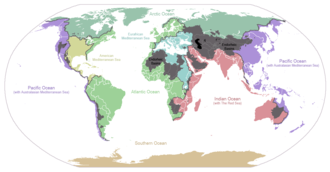Biogeographic realm
Biogeographic realms are large spatial regions within which ecosystems share a broadly similar biology. They are the broadest biotic division of the Earth's land surface, based on distributional patterns of terrestrial organisms. Biogeographic realms are used to describe patterns of organism distribution that reflect the evolutionary history of the planet, the movement of continental plates, and the flow of ocean currents, among other factors. They are a fundamental concept in the field of biogeography, which studies the distribution of species and ecosystems in geographic space and through geological time.
Definition and Characteristics
A biogeographic realm is defined by the unique life forms that inhabit it, shaped by the region's climate, geology, and geographical features. These realms are not strictly delimited, as they often blend into each other, forming transition zones that possess characteristics of adjacent realms. The concept of biogeographic realms is crucial for conservation biology, as it helps in the planning and implementation of biodiversity conservation strategies by identifying regions with unique biological communities.
Classification
The Earth's land surface is commonly divided into eight biogeographic realms:
- Nearctic: Covering most of North America, including Greenland and the highlands of Mexico.
- Palearctic: Encompassing Europe, North Africa, and most of Asia.
- Afrotropical: Covering sub-Saharan Africa and the southern Arabian Peninsula.
- Indomalayan: Extending over South Asia, Southeast Asia, and the southern part of East Asia.
- Australasian: Including Australia, New Guinea, New Zealand, and neighboring islands.
- Neotropical: Spanning South and Central America, the Caribbean, and the southern tip of Florida.
- Oceanian: Consisting of the islands of the central and south Pacific Ocean.
- Antarctic: Comprising Antarctica and its surrounding waters.
Each realm is characterized by distinct ecological and evolutionary histories, which are reflected in the diversity of life forms found within them.
Importance in Conservation
Understanding biogeographic realms is essential for global conservation efforts. It allows conservationists to prioritize regions for protection based on their unique biodiversity and the threats they face. By focusing on entire realms, conservation strategies can be more holistic, addressing the ecological processes that sustain biodiversity across large geographic areas.
Challenges and Future Directions
One of the main challenges in biogeographic realm conservation is the impact of climate change and human activities, which are altering habitats and the distribution of species at an unprecedented rate. Future research and conservation efforts need to consider these dynamic changes, employing adaptive management strategies that can respond to the shifting boundaries and compositions of biogeographic realms.
Transform your life with W8MD's budget GLP-1 injections from $125.
W8MD offers a medical weight loss program to lose weight in Philadelphia. Our physician-supervised medical weight loss provides:
- Most insurances accepted or discounted self-pay rates. We will obtain insurance prior authorizations if needed.
- Generic GLP1 weight loss injections from $125 for the starting dose.
- Also offer prescription weight loss medications including Phentermine, Qsymia, Diethylpropion, Contrave etc.
NYC weight loss doctor appointments
Start your NYC weight loss journey today at our NYC medical weight loss and Philadelphia medical weight loss clinics.
- Call 718-946-5500 to lose weight in NYC or for medical weight loss in Philadelphia 215-676-2334.
- Tags:NYC medical weight loss, Philadelphia lose weight Zepbound NYC, Budget GLP1 weight loss injections, Wegovy Philadelphia, Wegovy NYC, Philadelphia medical weight loss, Brookly weight loss and Wegovy NYC
|
WikiMD's Wellness Encyclopedia |
| Let Food Be Thy Medicine Medicine Thy Food - Hippocrates |
Medical Disclaimer: WikiMD is not a substitute for professional medical advice. The information on WikiMD is provided as an information resource only, may be incorrect, outdated or misleading, and is not to be used or relied on for any diagnostic or treatment purposes. Please consult your health care provider before making any healthcare decisions or for guidance about a specific medical condition. WikiMD expressly disclaims responsibility, and shall have no liability, for any damages, loss, injury, or liability whatsoever suffered as a result of your reliance on the information contained in this site. By visiting this site you agree to the foregoing terms and conditions, which may from time to time be changed or supplemented by WikiMD. If you do not agree to the foregoing terms and conditions, you should not enter or use this site. See full disclaimer.
Credits:Most images are courtesy of Wikimedia commons, and templates, categories Wikipedia, licensed under CC BY SA or similar.
Contributors: Prab R. Tumpati, MD



